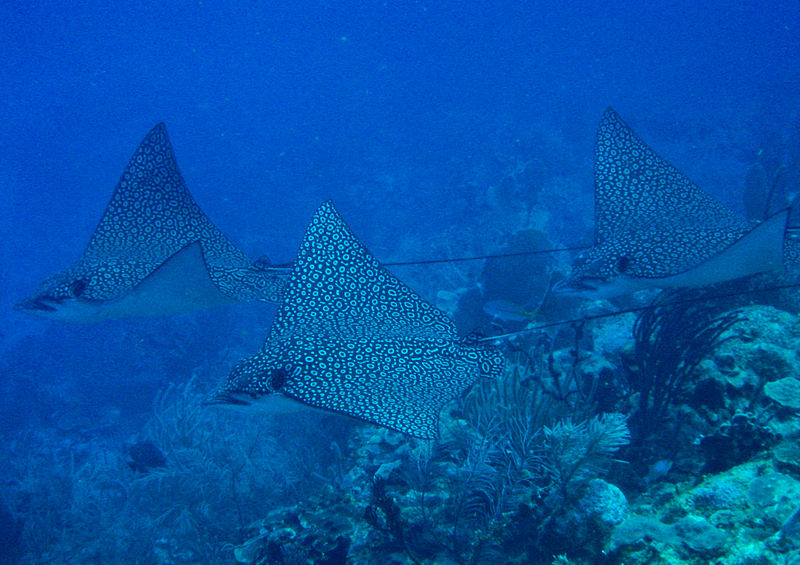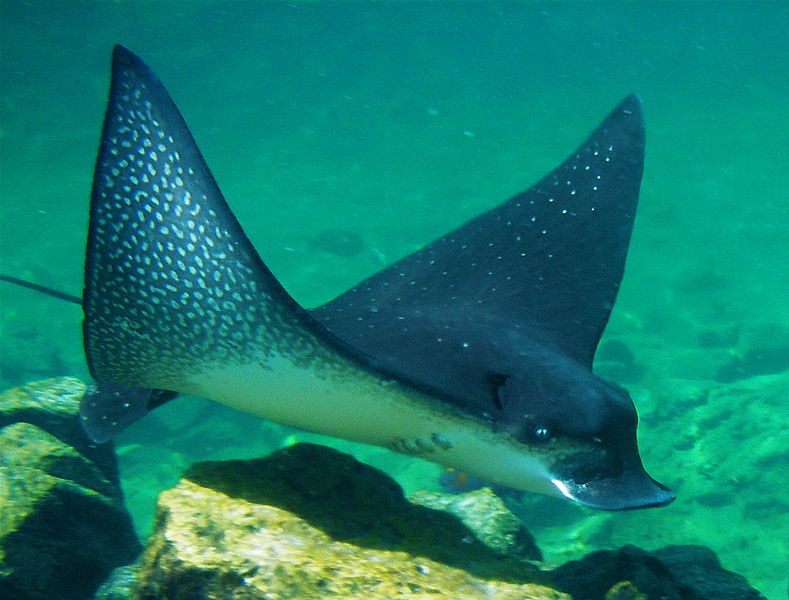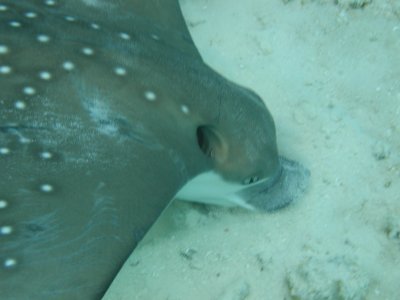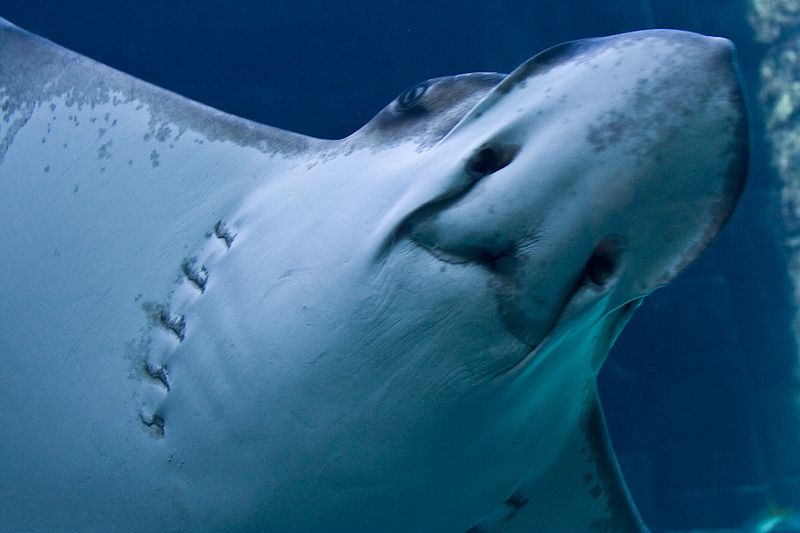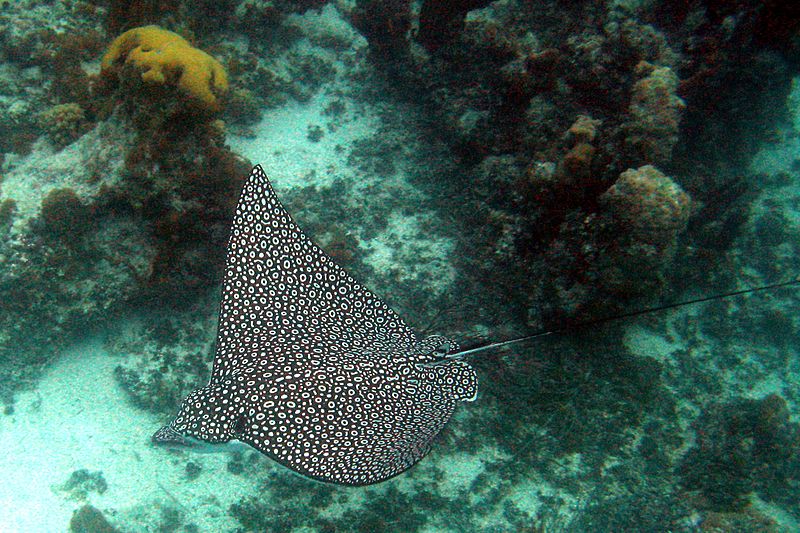Adaptation
The Aetobatus narinari looks similar to what most people imagine when thinking about a typical string ray, except it is much, much larger. The flattened disc-shaped body of a Spotted Eagle Ray measures up to 3.5 meters (about 11.5 feet) in width (Bester 2014). The body is usually twice as wide as it is long. Overall the length of A. narinari can reach up to 9 meters (about 29.5 feet) when including the whip-like tail. The tail is usually 2.5-3 times the width of the body (Bester 2014). The largest Spotted Eagle Ray weighed in at 230 kilograms (507 pounds) total (MarineBio 2014). The large, streamlined, flattened body of A. narinari allows for fast swimming and trans-oceanic migrations, which increases dispersal of the species globally (Schluessel et al. 2010).
Spotted Eagle Rays have a few different sets of fins that vary in shape
and size. The large pectoral fins of A. narinari are quite broad and
have pointed tips (Bester 2014). The pelvic fins are narrow and slightly
rounded. Males can be distinguished from females by the small
projections called claspers, which are found on the end of the pelvic
fins (Beautiful Oceans 2014). Located behind the pelvic fins is a small
dorsal fin (Bester 2014). All of the fins aid A. narinari in moving
gracefully through the water.
The mouth of A. narinari is located on the ventral side of the body,
which is ideal for feeding on benthic prey (Bester 2014). In addition,
Spotted Eagle Rays have a long, broad snout, which resembles a duckbill.
This comes in handy when digging into the sand to find prey such as
clams and oysters (Bester 2014). On occasion, Spotted Eagle Rays will turn
over rocks and even poke their heads into caves and other small rock
openings in search for food (Beautiful Oceans 2014).
Spotted Eagle Rays have a lateral line, similar to fish and sharks, which consists of canals running down both the ventral and dorsal sides of the body and around the head (Maui Ocean Center 2014). These allow A. narinari to sense changes in the motion of the water around them. This includes motion changes due to other organisms present as well as their own motion affecting the water around them. Spotted Eagle Rays can also sense change in temperature and pressure because of this adaptation (Pederson 2014).
Brain-body mass ratio is the primary way in which the overall
intelligence and complexity of marine life is determined and Spotted
Eagle Rays have one of the highest ratios (Beautiful Oceans 2014). This means
that the behaviors and social systems among A. narinari are more
advanced than other marine organisms.
A. narinari has an advanced sensory system including its eyes, spiracles
and sense of electroreception. The eyes are located on either side of
the head and are useful for viewing immediate threats as well as prey
(Pederson 2014). The spiracles are respiratory openings near the eyes and
close to the pectoral fins that enable the sense of smell as well as
ensure that water passes through the gills (Bester, Maui Ocean Center
2014).
Spotted Eagle Rays have two sets of five gills on each side of their
body on the ventral side. In order to breathe, A. narinari must be in
continuous swimming motion so that oxygen can be absorbed from the water
passing through the gills (Maui Ocean Center 2014).
Electroreception, which A. narinari has in common with sharks, is made possible by the electrosensory organs, which are more commonly known as “Ampullae of Lorenzini” (Pederson 2014). Spotted Eagle Rays have jelly filled pores along their snout and jaw and around the eyes, creating a network that increases sensitivity to their awareness of prey while hunting (Bester, Pederson 2014). This adaptation means that A. narinari can detect the electrical and magnetic energy fields of prey even when they are buried deep in the sand (Bester 2014).
Once A. narinari finds prey, it sucks it into its mouth which has a
strong jaw as well as broad, flat teeth that form a plate on the top and
bottom. The lower jaw has 3-6 anterior teeth, which protrude beyond the
upper tooth plate in order to crush shellfish when the mouth is closed
(Bester 2014). On the bottom and roof of their mouths Spotted Eagle Rays also
have a row of six or seven papillae, which remove shells from the prey
before it is ingested. The hard parts of the pray, such as shells, are
spat out and the soft parts are ingested (Beautiful Oceans 2014).
Spotted Eagle Rays get their name from the white circular pattern on
their darkly colored backs. A. narinari has a counter shading effect
that helps it to be disguised from predators (Maui Ocean Center 2014). The
dark patterned dorsal side, when viewed by predators from above,
camouflages into the reefs. When viewed from the ventral side the light
belly color disappears into the ocean surface (Maui Ocean Center 2014).
When the camouflage fails, Spotted Eagle Rays have backup plans for survival. Their cartilaginous skeletons also
A. narinari to perform evasive maneuvers when approached by predators such as sharp turns and sometimes even leaps out of the water if they are being chased (Maui Ocean Center, Beautiful Oceans 2014). When predators are close, the Spotted Eagle Ray’s final line of defense is the venomous sting from the spines located behind their dorsal fin. There are usually between two and six of these small, barb-tipped spines, which are quite powerful when utilized (Bester 2014).
<< Go back to our Home page! >>
